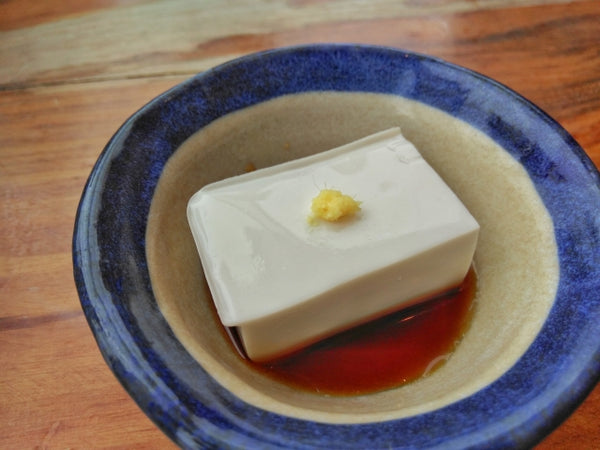Nuts about Jimami Tofu: The Low Down on Okinawa’s Unique Tofu

When I first stumbled across jimami tofu early on in my time in Japan, I mistook it for yet another version of Japan’s beloved flan-like dish, purin. Stumped by its jiggly smooth texture, I poured on the brown sauce that accompanied it assuming it was some sort of caramel, only to be met with the familiar taste of soy sauce. But after taking a bite, I fell in love with its delicious balance of sweet and salty. Soon after, jimami tofu became a staple on my shopping list.
Unlike regular tofu, which is made from soybeans, jimami tofu gets its nutty taste from peanuts. The peanuts are soaked in water, blended, and strained after which the resulting nut milk is heated and thickened with starch, which gives the tofu its signature jiggle. The mixture is then poured into a pan or mold and cooled in the fridge until solidified. When it is time to eat, it is turned out of the pan, cut into pieces, and served with a variety of toppings and sauces.
This simple dish was once served only at celebrations, but it has now become a standard item on izakaya menus across Okinawa. Jimami tofu has even made its way into souvenir shops, becoming a hit among tourists.
Jimami tofu has long been a staple in Okinawan culture, with some speculating that it was first invented over 120 years ago in the Yaeyama islands after locals were introduced to a similar variety of tofu made from sesame seeds. In the absence of an abundance of sesame seeds, Okinawans used what was available instead. “Jimami” or “jimame” means groundnut or ground bean in Okinawan dialect. Local peanuts have been a source of protein in the Okinawan diet for quite some time, with harvests usually hitting markets between the end of summer into October. Although these local harvests are now often supplemented with imported peanuts to keep up with demand, this local favorite is still readily available in most Okinawan supermarkets.

Jimami tofu is not entirely unique to Okinawa, however. Similar versions can be found in some areas of the Kyushu region of Japan such as Mei, Nagasaki, and Kagoshima going by the name of “dakkisho tofu”. This dish is endlessly versatile, dabbling in the worlds of both savory and sweet. Toppings for the peanut tofu vary from place to place. People in Okinawa tend to favor soy sauce and sometimes even add wasabi for a spicy kick, whereas it is commonly topped with salty umeboshi (Japanese pickled plums) and soy sauce in Kagoshima. In Nagasaki, jimami tofu is typically accompanied by yuzu zest (a Japanese citrus fruit with notes of lemon, mandarin, and grapefruit) or fruit and miso paste. In dessert form, it is often served with a sweetened soy sauce or black sugar syrup and grated ginger.
No matter the topping, jimami tofu offers a delightful departure from the standard soybean tofu. Simple and satisfying, it can even be made at home for a taste of island flavors anywhere.
About the author:

Nadine Pryor
Nadine first became interested in Japan and Japanese culture after working with an exchange program at her university. After hearing so many wonderful things from the exchange students she worked with she was longing for a chance to see Japan for herself. That opportunity came to her in the form of the JET program where she spent 5 years on a small island in the beautiful prefecture of Okinawa. While living in this very rural community of just under 1,300 people she was lucky to experience a glimpse into some of Okinawa’s unique traditions and culture. In her free time, she traveled the main island of Japan as well as eastern Asia, seeking out the most delicious foods and exciting experiences. She currently resides in the United States but hopes to return to Japan in the future.




